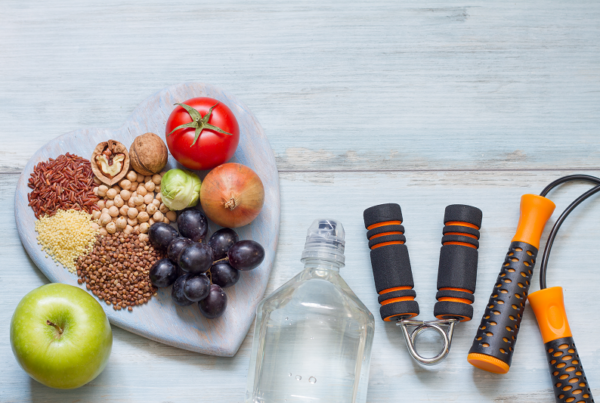
Today’s trip to the supermarket involves being faced with a myriad of choices and a bombardment of marketing ploys (clever marketers know that placing certain items at eye-level and targeting promotions at children – don’t get me started on this one – sells more so they don’t hesitate to use these tactics). Even smells are designed to encourage shoppers to spend more (and usually on cheap, processed goods that do our waistlines no favours at all); no surprise that I’m greeted with the smell of freshly baked goods on entrance to my local supermarket then.
But, by writing a weekly shopping list, you can beat the marketers at their own game and set yourself up for success with your weight loss and health goals (never mind making life a whole lot easier for yourself).
I make my own lists under the ‘notes’ section on my phone and, under my list, I write down a plan for what we’ll have for dinner each day. I always eat more healthily on those weeks I plan like that. And the very best weeks are the ones when I try a new recipe or two, as it introduces myself and the family to some new foods, helping to keep us interested and motivated. When I’m in ‘fly-by-the-seat-of-my-pants’ mode (i.e. during the summer often), my disorganisation often leads to me grabbing pizzas and baguettes more than usual but, thankfully, by this time of the year my lists are well and truly back on track (and my waistline correlates).
What does the Research Tell Us?
Armed with a weekly shopping list, you’re not only much more likely to stay on track with your weight loss plan, but you’ll also save money into the bargain. As simple as it sounds, making a list before shopping is an effective way to keep on track and those who do make lists tend to have lower BMIs. According to research findings, written shopping lists also significantly reduce average spending and – yet another bonus – those with a list also tend to finish their shopping more quickly.
Shopping lists remove the need for making decisions, which can in turn reduce impulse purchases and help shoppers resist ‘bargains’. Regularly sticking to a weekly shopping list makes it much more likely that you’ll buy food with a higher nutritional value (i.e. more wholesome food that will keep you fuller for longer versus highly processed foods that have been stripped of any nutritional value, leaving you feeling hungry and wanting more). Read more about this research here.
What Does a Healthy Weekly Shopping List Look Like?
You need to stock up on the following:
1. Lean Proteins: lean meat, fish (include oily varieties where possible, such as salmon, tuna or mackerel), chicken, turkey, tofu, lentils (great for soups), chickpeas (or other tinned beans like cannellini/red kidney) and eggs. Hummus and peanut butter are also great spreads to have to hand (and both are great sources of protein).
2. Colourful Veg: fibre-filled vegetables of all kinds including green and red peppers, tenderstem broccoli, pal choi, asparagus, celery, tomatoes, cauliflower and even frozen spinach/peas (for when you’ve run out of the fresh stuff).
3. Discerning Dairy: most Irish households go through a lot of milk but you can also include non-dairy varieties if you wish, such as soya or almond (stick to the amount advised by your weight loss consultant). Greek yoghurt is a great addition to the trolley as it’s high in protein and low in sugar, providing a satisfying, filling snack (avoid the sugary yoghurts for children if possible. If they only eat sweetened yoghurt, just add a bit of honey into a pot for school lunches). As regards cheese, cottage cheese is a great one if you like it, or else your favourite cheddar, parmesan or feta is fine, as long as you stick to the correct portion, which is 1oz and looks like a domino.
4. Sugar-free Flavourings: don’t forget stock cubes, balsamic vinegar, mustard (grainy or traditional), soya sauce and Ballymaloe relish to liven up your food. And lemons provide a wonderful natural flavouring so include those too!
5. High Protein Nuts and Seeds: I’m a big fan of chia seeds (full of omega-3s and a source of protein), flaxseed, hemp seed (great added to smoothies to boost protein content) and pumpkin seeds (a good source of zinc which can help to strengthen the immune system throughout winter). When it comes to nuts, the best ones for weight loss are always almonds (blanched or whole) and walnuts, although small amounts of cashews or dry roasted peanuts are fine every now and then too.
6. Lower Sugar Fruits: go for the ones less likely to convert to sugar so quickly, so the berries (strawberries, blueberries and raspberries) are best. Don’t go to heavy handed on the bananas as they are higher in sugar, and just one half of a banana equates to one serving of fruit, yet you get a decent helping of strawberries for that same serving.
7. Low-Release Carbs: go for the less bulky ones and try wholemeal wherever possible, so things like wraps and wholemeal pitta breads are ideal. And always opt for brown rice and wholemeal pasta over the white varieties. Weetabix and porridge are the very best breakfasts for children (low sugar AND slow release) – try to avoid the other, higher sugar ones (or just buy every now and then).
8. Plenty of Liquids: with all the plastic debate at the moment, I’m a bit torn on my addiction to bottled water. Maybe try to buy glass instead? But if the only way you’ll get in your 2 litres a day is to buy the fizzy stuff, then splash out. I know one client who treats herself to 7 bottles of Pellegrino with lemon and mint each week (substituting an age-old habit of downing 3 glasses of wine per night, and she says she doesn’t even miss it!). Don’t forget herbal teas as well – a great distraction in the evening when you are craving something – my favourite is roiboos but others love peppermint, chamomile or green tea.
9. Protein Supplements: for your in-between snacks, don’t look any further than our low sugar, low calorie ‘treats’ including bars, drinks and soups which you can buy online. Also I like to include a few squares of dark chocolate as a treat (above 70 or 80% ideally). And a jar of olives is very handy for when I’m feeling peckish (low in calories and a good source of healthy fats).
Try ‘Perimeter Shopping’
Perimeter shopping is a great way to emphasise fresh foods while minimising your exposure to packaged and processed items. The perimeter of most supermarkets usually includes fruits, vegetables, healthy proteins and dairy.
Though interior grocery aisles include many healthy options, such as canned and dried beans, grains, spices and olive oil, this is also where most supermarkets stock highly processed foods like sweets and fizzy drinks – so beware!
Research shows that minimising your time in the interior of the grocery store can reduce your exposure to these unhealthy foods, reducing your chances of being tempted to purchase them.
Try this out, for a while at least, and measure the results – take pen and paper and prepare your weekly shopping list. I’ll bet you’ll be pleasantly surprised.



